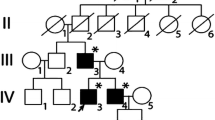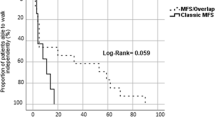Abstract
Familial dysautonomia (FD) is a genetic disease associated with a high incidence of sudden death. If fatal bradyarrhythmia is an etiological factor then the incidence of sudden death should decrease after pacemaker placement. Retrospective review of 596 registered FD patients revealed that 22 FD patients (3.7%) had pacemakers placed between December 1984 and June 2003. Clinical and electrocardiographic indications for placement and demographic data were assessed for 20 of the 22 patients (10 males, 10 females, ages 4 to 48 years). Two patients were excluded because of insufficient data. Prior to pacemaker placement, presenting symptoms were syncope and cardiac arrest, 16/20 (80%) and 6/20 (30 %), respectively. Asystole was the most frequent electrocardiographic finding and was documented in 17/20 patients (85 %). Other electrocardiographic abnormalities included bradycardia, AV block, prolonged QTc and prolonged JTc. The average duration of pacemaker utilization was 5.7 years (range 5 months to 14.5 years). Complications included infection (1 patient) and wire migration (2 patients). In the one patient with infection, the pacemaker was permanently removed. This patient then experienced multiple syncopal episodes and death. There were 7 other deaths. Three deaths occurred suddenly without preceding events, and 4 patients had non-cardiac causes of death. None of these 7 deceased patients had recurrence of syncope after pacemaker placement. In the 12 surviving patients, 6 had recurrence of syncope but none had cardiac arrest. Pacemaker placement may protect FD patients from fatal bradyarrhythmia and may decrease the incidence of syncope. However, data are limited and prospective analysis is needed.
Similar content being viewed by others
References
Ackerman MJ (1998) The long QT syndrome. Mayo Clin Proc 73:250–269
Anderson SL, Coli R, Daly IW, Kichula EA, Volpi SA, Ekstein J, Rubin BY (2001) Familial dysautonomia is caused by mutations of the IKAP gene. Am J Hum Genet 68:753–758
Axelrod FB (1996) Autonomic and Sensory Disorders. In: Emory AEH, Rimoin DL (eds) Principles and Practice of Medical Genetics. 3rd ed. Churchill Livingstone, Edinburgh, pp 397–411
Axelrod FB (2002) Hereditary Sensory and Autonomic Neuropathies: Familial Dysautonomia and other HSANs. Clin Auton Res 12(Supplement 1):2–14
Axelrod FB, Abularrage JJ (1982) Familial dysautonomia. A prospective study of survival. J Pediatr 101:234–236
Axelrod FB, Glickstein JS, Weider J, Gluck MC, Friedman D (1993) The effects of postural change and exercise on renal haemodynamics in familial dysautonomia. Clin Auton Res 3:195–200
Axelrod FB, Goldberg JD, Ye XY, Maayan C (2002) Survival in familial dysautonomia. Impact of early intervention. J Pediatr 141:518–523
Axelrod FB, Maayan C,Hazzi C, Bangaru B, Shannon D (1987) Bradycardia associated with hiatal hernia and gastroesophageal reflux relieved by surgery. Am J Gastro 82:159–161
Axelrod FB, Putman D, Berlin D, Rutkowski M (1997) Electrocardiographic measures and heart rate variability in patients with familial dysautonomia. Cardiology 88:133–140
Bernardi L, Hilz M, Stemper B, Passino C, Welsch G, Axelrod FB (2002) Respiratory and cerebrovascular responses to hypoxia and hypercapnia in familial dysautonomia. Am J Respir Crit Care Med 167:141–149
Bickel A, Axelrod FB, Schmetz M, Marthal H, Hilz MJ (2002) Dermal microdialysis provides evidence for hypersensitivity to noradrenaline in patients with familial dysautonomia. J Neurol Neurosurg Psychiatry 73:299–302
Brown CM, Stemper B, Welsch G, Brys M, Axelrod FB, Hilz MJ (2003) Orthostatic challenge reveals impaired vascular resistance control but normal venous pooling and capillary filtration in Familial Dysautonomia. Clinical Science 104:163–169
Browne KF, Prystowsky E, Meyer JJ, Chilson DA, Zipes DP (1983) Prolongation of the QT interval in man during sleep. Am J Cardiol 52:55–59
Connolly SJ, Sheldon R, Thorpe KE, Roberts RS, Ellenbogen KA, Wilkoff BL,Morillo D, Gent M (2003) Pacemaker therapy for prevention of syncope in patients with recurrent severe vasovagal syncope. JAMA 289:2224–2229
Edelman NH, Cherniack NS, Lahiri S, Richards E, Fishman AP (1970) The effects of abnormal sympathetic nervous function upon the ventilatory response to hypoxia. J Clin Invest 41:1153–1165
Glickstein JS, Axelrod FB, Friedman D (1999) Electrocardiographic repolarization abnormalities in familial dysautonomia: an indicator of cardiac autonomic dysfunction. Clin Auton Res 9:109–112
Glickstein JS, Schwartzman D, Friedman D, Rutkowski M, Axelrod FB (1993) Abnormalities of the corrected QT interval in familial dysautonomia: an indicator of autonomic dysfunction. J Pediatr 122:925–928
Grover-Johnson N, Pearson J (1976) Deficient vascular innervation in familial dysautonomia, an explanation for vasomotor instability. J Neuropath Appl Neurobiol 2:217–224
Grubb BP, Kosinski DJ (2001) Syncope resulting from autonomic insufficiency syndromes associated with orthostatic intolerance. Medical Clinics of NA 85:457–472
Hilz MJ, Axelrod FB, Braeske K, Stemper (2002) Cold pressor test demonstrates residual sympathetic cardiovascular activation in familial dysautonomia. J Neurol Sci 196:81–89
Hilz MJ, Axelrod FB, Haertl U, Brown CM, Stemper B (2002) Transcranial doppler sonography during head up tilt suggests preserved central sympathetic activation in familial dysautonomia. J Neurol Neurosurg Psychiatry 72:657–660
Hilz MJ, Axelrod FB, Sauer P, Hagler A, Russo H, Neundorfer B (1997) Cold face stimulation demonstrates parasympathetic dysfunction in familial dysautonomia. J Auton Nerv Sys 65:111
Kapoor WN (2003) Is there an effective treatment for neurally mediated syncope? JAMA 289:2272–2275
Pearson J, Axelrod FB, Dancis J (1974) Current concepts of dysautonomia. Neurological defects. Ann NY Acad Sci 228:288–300
Raj SR, Kashman MK, Sheldon RS (2003) Outcome of patients with dualchamber pacemakers implanted for the prevention of neurally mediated syncope. Am J Cardiol 91:565–569
Rutkowski M, Axelrod FB, Danilowicz D (1992) Transient third-degree atrioventricular block in a 4-year-oldchild with familial dysautonomia. Pediatr Cardiol 13:184–186
Slaugenhaupt SA, Blumenfeld A, Gill SP, et al. (2001) Tissue-specific expression of a splicing mutation in the IKBKAP gene causes familial dysautonomia. Am J Hum Genet 68:598–605
Sutton R, Brignole M, Menozzi C, Raviele A, Alboni P, Giani P, Moya A (2000) Dual-chamber pacing in the treatment of neurally mediated tiltpositive cardioinhibitory syncope: pacemaker versus no therapy: a multicenter randomized study. The Vasovagal Syncope International Study (VASIS) Investigators. Circulation 102:294–299
Ziegler MG, Lake RC, Kopin IJ (1976) Deficient sympathetic nervous system response in familial dysautonomia. N Engl J Med 294:630–633
Author information
Authors and Affiliations
Corresponding author
Additional information
Grant support: This study was supported by a Center grant from the Dysautonomia Foundation, Inc. New York, NY.
Rights and permissions
About this article
Cite this article
Gold-von Simson, G., Rutkowski, M., Berlin, D. et al. Pacemakers in patients with familial dysautonomia. Clin Auton Res 15, 15–20 (2005). https://doi.org/10.1007/s10286-005-0218-2
Received:
Accepted:
Issue Date:
DOI: https://doi.org/10.1007/s10286-005-0218-2




